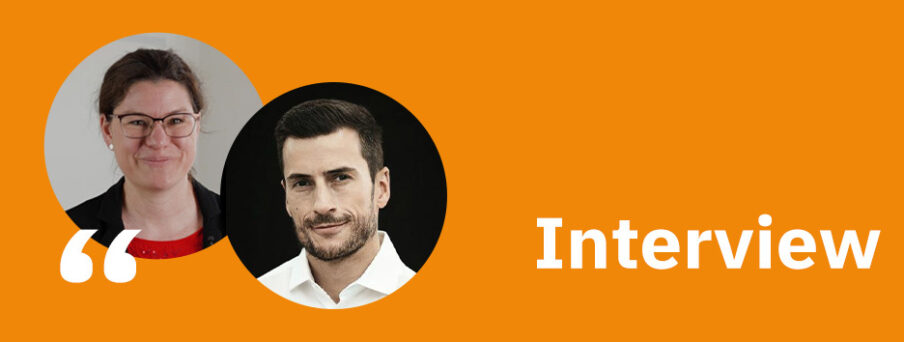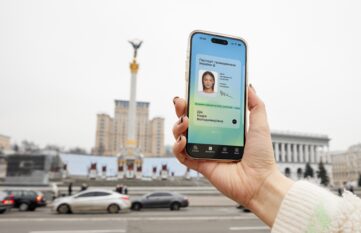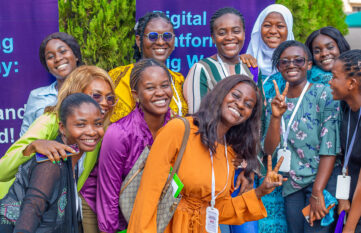Mission-Oriented Innovation to bring more women online! Interview with Noémie Bürkl and Benjamin Kumpf

The German Federal Ministry for Economic Cooperation and Development (BMZ) and the Organisation for Economic Co-operation and Development (OECD) have launched a joint pilot programme on “Mission-oriented innovation (MOI) to close the gender digital divide”. Worldwide, 244 million fewer women than men are online, although an online presence is increasingly essential for social, economic, and democratic participation.
The gender digital divide is particularly pronounced in low- and middle-income countries (LMICs). To address this challenge, BMZ and the OECD Innovation for Development Facility (INDEF) have launched the joint pilot program. Its aim is to support partner governments in closing the gender digital divide and developing suitable implementation strategies using a mission-oriented approach.
An interview with Noémie Bürkl (Head of Division Digitalisation, BMZ) and Benjamin Kumpf (Head, OECD INDEF) to kick off the programme.
Let’s start at the beginning: What exactly is “mission-oriented innovation”? Or in other words: What is the pilot program with the OECD about?
Noémie Bürkl: Admittedly, “mission-oriented innovation” – in short MOI – is a rather unknown concept, to begin with. The idea behind it is a policy that defines concrete and measurable goals, without prescribing solutions. This sounds contradictory at first, but can be an effective approach to tackling complex social challenges such as climate protection – problems that cannot be solved with a vertical approach in a single area.
Overcoming the gender digital divide is also a good example of this: it is not sufficient to get more women interested in the IT sector or to teach a few thousand girls how to program. Instead, it’s a challenge that needs to be tackled from many different angles – education, regulation, access, cultural barriers, for example – and for which there is no single, simple solution. This is where MOI comes in – turning the tables and defining a clear goal. Let me give a fictitious example: We want to double the number of women with access to the Internet in ten years. It is then up to politicians to design together cross-departmental and cross-sectoral packages of political and regulatory measures to achieve this goal.
While the MOI approach has already proven itself in industrialised countries, the level of knowledge on the benefits of it in middle- and low-income countries (LMICs) is limited. In cooperation with the partner governments in Colombia and the Dominican Republic, BMZ and OECD want to increase the level of knowledge in LMICs and accelerate the promotion of gender equality in the digital age. The OECD is a valued partner organisation in this context, as it has special expertise on MOI and promotes international knowledge exchange on the topic. The findings of the pilot program, especially on the use of the method in promoting gender equality, can also be beneficial for future development policy initiatives.
Mr. Kumpf, how have innovation strategies developed in the recent years and what exactly is meant by mission-oriented innovation policy?
Benjamin Kumpf: The normative orientation of innovation strategies is not new. What has been new in the last ten years, however, is the development of new technological and process innovations as well as new forms of cooperation. Today, there are cross-sectoral innovation portfolios and a variety of funding mechanisms, some of which are still in the testing phase. The U.S. government’s “Energy Earthshot” mission and the Korean government’s “Alchemist” program are examples of missions that rely on new technologies and are implemented through financial and technical support. The latter follows a “stage-gating” approach: each phase of the innovation process is funded, and further support is provided only after pre-defined indicators have been achieved.

© GIZ
Generally, it is important that missions are broadly anchored in society and obtain long-term financing, which can be challenging in development cooperation. So far, the mission-oriented approach has been used mainly in OECD countries that have developed innovation capacities, but interest is growing worldwide.
Benjamin Kumpf, Head of OECD INDEF
Therefore, I founded the “OECD Mission Action Lab” with colleagues, to research missions in different countries and to promote the exchange of knowledge between OECD member states and less developed countries. It is important to emphasise that both sides always learn from each other.
What does the OECD Innovation for Development Facility do in relation to mission-oriented innovation policy?
Benjamin Kumpf: In recent years, we have been looking at various forms of mission-oriented innovation policy: On the one hand, missions initiated by governments, such as India’s goal of supplying all households with drinking water by 2024; on the other hand, transnational missions jointly formulated by governments and development agencies, such as the “Family Planning 2030” mission, which aims to provide women with access to contraceptives. We also examined the strategies of specialised organisations, such as the UK’s innovation agency Nesta and Sweden’s Vinnova, to support such missions. An important finding of our research is that in LMICs, the national and local ministries of research and innovation are often hardly involved in missions. This is contrary to practices in the EU and points to a neglect of these actors.
Why is it so important for the BMZ to pursue a feminist digital policy?
Noémie Bürkl: You can look at the gender digital divide from two perspectives. On the one hand, there is the issue of justice: despite increasing global connectivity, women in particular are excluded from the opportunities of the digital transformation in our partner countries – of participation, jobs, knowledge and information. The reasons for this include a lack of access to mobile devices, a lack of digital skills or gender-specific online violence. The gender digital divide is particularly large in LMICs, and in parts even growing.
The other perspective is an economic one: In the long term, the lack of women’s digital participation causes heavy financial losses. Without gender digital divide, these countries could increase their economic activity by an estimated 524 billion US dollars by 2025 and thus advance their sustainable development. Mission-oriented innovation policy can be a way to drive this change and make progress in closing the gender digital divide.
Noémie Bürkl, Head of Division Digitalisation, BMZ
What will be the cooperation with the partner countries as part of the program look like?
Benjamin Kumpf: We use an ‘action research’ approach, in which a concrete benefit is generated for our partners. We are currently talking to colleagues from planning and information and communication technology (ICT) ministries as well as regulatory authorities to formulate common goals and carry out ‘mission diagnostics’. In doing so, we analyse existing collaboration and financing mechanisms as well as the political anchoring of the mission in society. We use tools such as surveys, interviews, and workshops to generate knowledge. To further develop policy approaches, we will then present the diagnosis and an options menu, involving partners from OECD countries with experience with MOI approaches. This involves dialogue based on partnership, from which all sides benefit, as well as the establishment of new partnerships. It’s not about one-sided learning from north to south.
In what form will the results of the program be processed, so that partner countries and development cooperation actors can benefit from it?
Benjamin Kumpf: For the actors from politics, business and society in the respective partner countries, we will work with our partners to develop a country-specific diagnosis, which will then be discussed in a final seminar. For actors in development cooperation as a whole, we will derive a working paper and also shorter articles. Beyond the papers, it is important to us to provide useful insights in the long term. For this reason, we seek exchanges with organisations that are interested in the approach and are happy to present our results for discussion.

Noémie Bürkl © GIZ
Noémie Bürkl is the Deputy Chief Digital Officer and Head of the Digital Technologies Unit at the Federal Ministry for Economic Cooperation and Development (BMZ) in Berlin since February 2023. Previously she served as the Deputy Head of Unit for Multilateral Policy, co-headed the German-Bilateral Cooperation at the German Embassy in Cairo, and worked as a Senior Policy Officer at the Federal Foreign Office as well as a Technical Program Officer at the International Organization for Migration. She studied International and European Relations in France and Canada and completed a Master’s degree in International Economics and Politics in Prague.

© GIZ
Benjamin Kumpf is the Head of Innovation for Development Facility at the OECD Development Co-operation Directorate. Prior to joining the OECD, he worked as Head of Innovation at the UK Foreign, Commonwealth and Development Office and led the Innovation Facility of the United Nations Development Programme. In these capacities, he managed flexible funds to support experimentation, exploration and the scaling-up of development innovations, co-led programmes on adaptive management and advised country offices and partners on strategic innovation opportunities. Past posts include work with UN Volunteers, with the German Agency for International Cooperation (GIZ), the International Agricultural Research Institute for the Semi-Arid Tropics and others in India, Jordan, Nepal and Rwanda. He is a member of several advisory bodies to advance innovation in the development and humanitarian sectors and he teaches as Adjunct Professor at Columbia University, New York, at Sciences Po, Paris and at IE Madrid University.


